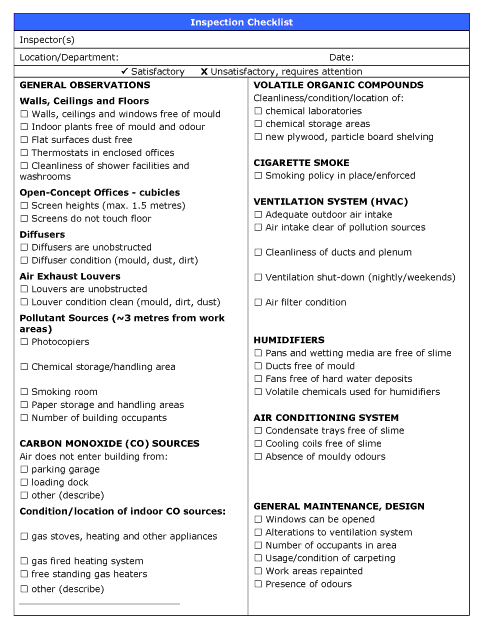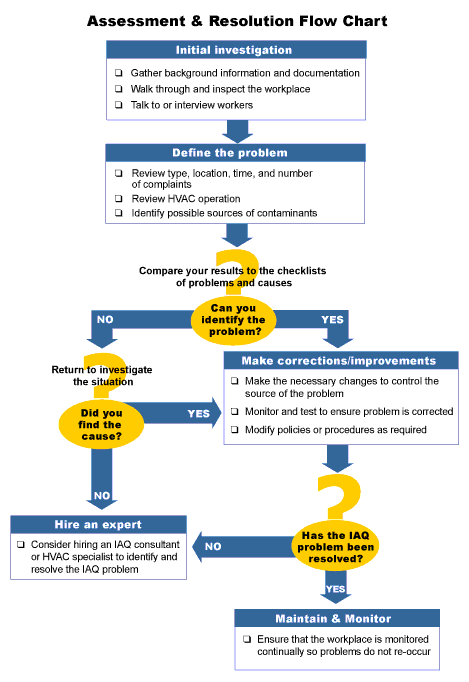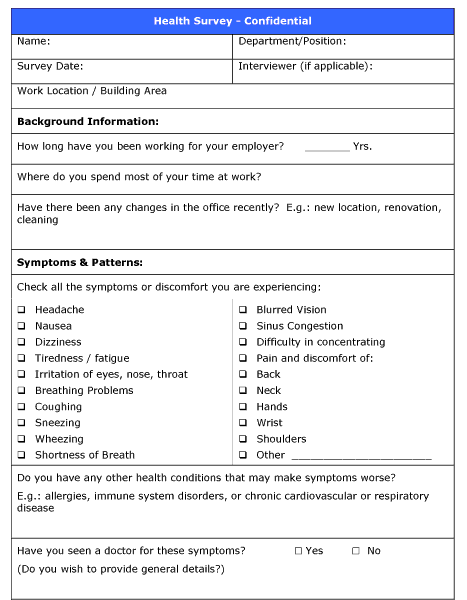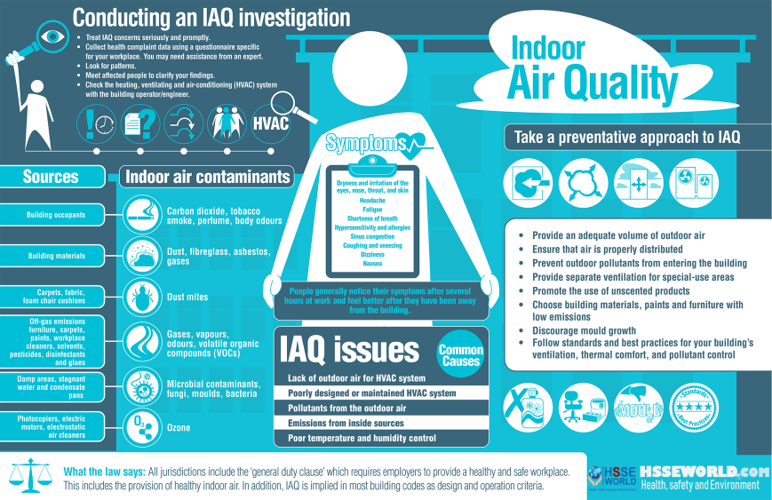Many of us spend our working hours indoors. The quality of the air we breathe can significantly affect our comfort, productivity, and health.
Poor indoor air quality (IAQ) can create an unpleasant or uncomfortable work environment, which in turn can affect morale, productivity, and employee well-being. In more serious situations, employees’ health can be at stake. It is important to address all IAQ concerns seriously and without delay. Even situations that at first appear to be trivial can lead to more severe problems if left unchecked.
The photo of today and below infographic describes the symptoms of IAQ, common causes, and what workplaces can do when it comes to both investigating IAQ complaints and proactively improving air quality at work.

Indoor Air Pollution and Health
Indoor Air Quality (IAQ) refers to the air quality within and around buildings and structures, especially as it relates to the health and comfort of building occupants. Understanding and controlling common pollutants indoors can help reduce your risk of indoor health concerns.
Health effects from indoor air pollutants may be experienced soon after exposure or, possibly, years later.
Immediate Effects
Some health effects may show up shortly after a single exposure or repeated exposure to a pollutant. These include irritation of the eyes, nose, and throat, headaches, dizziness, and fatigue. Such immediate effects are usually short-term and treatable. Sometimes the treatment is simply eliminating the person’s exposure to the source of the pollution if it can be identified. Soon after exposure to some indoor air pollutants, symptoms of some diseases such as asthma may show up, be aggravated, or worsened.
The likelihood of immediate reactions to indoor air pollutants depends on several factors including age and preexisting medical conditions. In some cases, whether a person reacts to a pollutant depends on individual sensitivity, which varies tremendously from person to person. Some people can become sensitized to biological or chemical pollutants after repeated or high-level exposures.
Certain immediate effects are similar to those from colds or other viral diseases, so it is often difficult to determine if the symptoms are a result of exposure to indoor air pollution. For this reason, it is important to pay attention to the time and place symptoms occur. If the symptoms fade or go away when a person is away from the area, for example, an effort should be made to identify indoor air sources that may be possible causes. Some effects may be made worse by an inadequate supply of outdoor air coming indoors or from the heating, cooling, or humidity conditions prevalent indoors.
Long-Term Effects
Other health effects may show up either year after exposure has occurred or only after long or repeated periods of exposure. These effects, which include some respiratory diseases, heart disease, and cancer, can be severely debilitating or fatal. It is prudent to try to improve the indoor air quality in your home even if symptoms are not noticeable.
While pollutants commonly found in indoor air can cause many harmful effects, there is considerable uncertainty about what concentrations or periods of exposure are necessary to produce specific health problems. People also react very differently to exposure to indoor air pollutants. Further research is needed to better understand which health effects occur after exposure to the average pollutant concentrations found in homes and which occur from the higher concentrations that occur for short periods of time.
The common causes of IAQ problems
IAQ problems result from interactions between building materials and furnishing, activities within the building, climate, and building occupants. IAQ problems may arise from one or more of the following causes:
- Indoor environment – inadequate temperature, humidity, poor air circulation, ventilation system issues.
- Indoor air contaminants – chemicals, dust, molds or fungi, bacteria, gases, vapors, odors.
- Insufficient outdoor air intake.
Indoor air contaminants
Here are examples of common indoor air contaminants and their main sources:
- Carbon dioxide (CO2), tobacco smoke, perfume, body odors – from building occupants.
- Dust, fiberglass, asbestos, gases, including formaldehyde – from building materials.
- Toxic vapors, volatile organic compounds (VOCs) – from workplace cleaners, solvents, pesticides, disinfectants, glues.
- Gases, vapors, odors – off-gas emissions from furniture, carpets, and paints.
- Dust mites – from carpets, fabric, foam chair cushions.
- Microbial contaminants, fungi, molds, bacteria – from damp areas, stagnant water, and condensate pans.
- Ozone – from photocopiers, electric motors, electrostatic air cleaners.
Symptoms are often linked to poor indoor air quality
It is common for people to report one or more of the following symptoms:
- Dryness and irritation of the eyes, nose, throat, and skin
- Headache
- Fatigue
- Shortness of breath
- Hypersensitivity and allergies
- Sinus congestion
- Coughing and sneezing
- Dizziness
- Nausea
People generally notice their symptoms after several hours at work and feel better after they have left the building or when they have been away from the building for a weekend or a vacation.
Many of these symptoms may also be caused by other health conditions including common colds or the flu, and are not necessarily due to poor IAQ. This fact can make identifying and resolving IAQ problems more difficult.
Some related health issues?
Occupants of buildings with poor IAQ report a wide range of health problems which are often called Sick Building Syndrome (SBS) or Tight Building Syndrome (TBS), Building-Related Illness (BRI), and Multiple Chemical Sensitivities (MCS).
The term sick building syndrome (SBS) is used to describe cases in which building occupants experience adverse health effects that are apparently linked to the time they spend in the building. However, no specific illnesses or causes can be identified.
Building-Related Illness (BRI) refers to less frequent (but often more serious) cases of people becoming ill after being in a specific building at a certain time. In these cases, there is usually a similar set of clinical symptoms experienced by the people, and a clear cause can often be found upon investigation. Legionnaires Disease is an example of BRI caused by bacteria that can contaminate a building’s air conditioning system.
A certain percentage of workers may react to a number of chemicals in indoor air, each of which may occur at very low concentrations. Such reactions are known as multiple chemical sensitivities (MCS). Several medical organizations have not recognized multiple chemical sensitivities. However, a medical opinion is divided, and further research is needed.
Is air contamination the only cause of these symptoms?
No. Feelings of discomfort and illness may be related to any number of issues in the total indoor environment. Other common causes may include noise levels, thermal comfort (temperature, humidity, and air movement), lighting, and ergonomics. It is important that all possible causes be investigated when assessing complaints.
(read more : E-books indoor-air-pollution/)
Why do only some people seem to develop symptoms?
As with any other occupational illness, not all people are affected with the same symptoms or to the same extent. Some people may be more sensitive than others. Some people may be exposed to more contaminants in the building than others and they may experience symptoms earlier than other people. As air quality deteriorates and/or the length of exposure increases, more people tend to be affected and the symptoms tend to be more serious.
Can a person become sensitive to IAQ contaminants as time passes?
It seems possible. Some people may not be sensitive to IAQ problems in the early years of exposure but can become sensitized as exposure continues over time.
When should I start suspecting that IAQ may be a problem?
When there is a problem with IAQ, people may experience various health conditions that are listed above. Since many of the symptoms are very similar to what we feel like when coming down with a cold or the flu (influenza), it is often difficult to say for sure if the indoor air is the cause of the symptoms.
However, it would be prudent to investigate IAQ if people develop these symptoms within a few hours of starting the workday and feel better after leaving the building, or after a weekend or vacation. In addition, if many people report similar symptoms, or if all of the people reporting symptoms work in the same area of a building, air quality should be suspected.
Indoor Air Quality and Environmental Justice
EPA defines environmental justice (EJ) as “the fair treatment and meaningful involvement of all people regardless of race, color, national origin, or income with respect to the development, implementation, and enforcement of environmental laws, regulations, and policies.”
To effectively address EJ concerns, the Agency recognizes that communities must be the impetus for implementing local solutions for environmental health problems including indoor air. However, far too many communities lack the capacity to truly affect their environmental conditions. This includes some conditions found indoors, as well as conditions caused by outdoor impacts (such as climate change).
Many reports and studies indicate that the following populations may be disproportionately impacted by indoor asthma triggers, secondhand smoke, mold, radon, and other indoor pollutants:
- children
- elderly
- low-income
- minority
- Tribes and indigenous people.
EPA’s Indoor Environments Division (IED) provides guidance and programs to help build the capacity of communities to understand and avoid indoor and outdoor health impacts. IED’s main objective is to improve indoor air quality in buildings where people live, learn and work.
Why can’t I use regular chemical occupational exposure limits for indoor air contaminants?
It is not recommended that “regular” occupational exposure limits (e.g., OELs, TLVs®, PELs) be used to determine if the general indoor air quality meets a certain standard. Occupational exposure limits listed in health and safety regulations and the Threshold Limit Values® (TLVs) recommended by the American Conference of Governmental Industrial Hygienists (ACGIH) are intended as a guide to prevent illness or certain effects (like eye and nose irritation) in industrial situations. These limits may not be appropriate in office settings or for the home.
Occupational exposure limits use dose-response data which show the health effects of repeated exposure to one specific chemical. Similar data is not available for long-term, low-level exposures to a combination of contaminants as is the case for IAQ problems. Currently, there is not enough information available to predict the effects of exposure to several potentially harmful agents at the same time.
How do I investigate possible IAQ problems?
Typically people will report that they are experiencing symptoms believed to be caused by IAQ. Unfortunately finding the source or cause can often be difficult. The steps taken may vary from situation to situation but will include:
- Investigate the ventilation system to make sure it is operating properly (e.g., the right mix of fresh air, proper distribution, filtration systems are working, etc.).
- Look for possible causes (e.g., source of a chemical, renovations, mold, etc.). (see a sample Inspection Checklist, below).
- Rule out common causes of the symptoms such as noise, thermal comfort, humidity, ergonomics, lighting, etc.
- Conduct a survey to help pinpoint work sources and causes (see below for a sample survey).
- Consider help and/or air testing by a qualified professional.
What is a sample inspection checklist for IAQ?

Who should investigate?
Many people may play a role in helping to resolve an IAQ problem including the building owner, employer, property manager, and occupants. Who conducts your investigation will depend on your workplace, but in general, you should have one person who is the leader, and perhaps a small team, including a representative from the worksite health and safety committee, or the union, if appropriate. The expertise of many other people such as health and safety or building maintenance personnel, and the experience of everyone in the workplace will all be important in finding the root cause of your IAQ problem.
What are a sample Assessment and Resolution flow chart for IAQ?

What is an example of a health survey that I can use to help identify if IAQ is related to reported problems?
The following is a sample of a questionnaire that could be used to help identify if an office or building has an indoor air quality problem.
- Use this questionnaire in consultation with a health and safety professional or other experts (s).
- Modify or customize this questionnaire to address the conditions and work practices at your workplace.
- Analyze the responses in consultation with an expert.
SAMPLE HEALTH SURVEY (Adapted from Indoor Air Quality Health and Safety Guide,)


What should I do if I suspect that I am ill from poor IAQ?
If you think that you may be ill from IAQ problems, it is important to keep track of when you get your symptoms (aches, pains, headaches, etc.) and when they go away. This record will help your safety officer or health professional determine what the problem is related to. You may also wish to discuss you symptoms with your health professional to rule out any other medical conditions.
As with any other occupational health and safety concern, you can discuss your concerns with the health and safety representative, the health and safety committee, your supervisor, safety coordinator, industrial hygienist, or any other member of your company that is responsible for health and safety.
Your local government jurisdiction may also be able to provide information and advice on workplace health and safety. Document last updated on July 4, 2016
Download Infographic
Indoor Air Quality
More Photos
- What are the Best Practices for Managing Subcontractor Risk
- Photo of the day: 10 Essential Safety Tips for Driving in Hot Weather Conditions
- Photo of the day: best workplace safety tips
- Photo of the day: The Importance of Stop Work Authority in Maintaining Workplace Safety
- Photo of the day: Tomorrow’s Reward for Working Safely Today: Cultivating a Culture of Safety
- Photo of the day: Preventing slips and trips at work
- Photo of the day: Learn the DRSABCD action Plan
- Working with Electricity Electrical Accidents Guide for Electrical Workers
- Photo of the day: Hearing Protection Device Selection
- Photo of the day: If An Earthquake Shakes You-Infographic free
- Fire Safety Posters Free Download
- Photo of the day: First Aid for Electrical Burns-Infographic free
- Infographic: First Aid for Cuts and Scrapes free download
- Photo of The day: Work Safe with Lasers-Laser Safety free
- Photo of the day: Working Safely with chemicals and chemical Management
- Photo of the day: Safe work practices when using MEWPs ( updated)
- Photo of the day: Preventing Common Kitchen Hazards
- Photo of the day: Safe handling of Gas Cylinders and lecture bottles
- Photo of the day: Forklift Stability Triangle
- Photo of the day: Defective Tools Safe Work Practice
- Photo of the day: Lift With Your Legs Not With Your Back
- Photo of the day: First Aid for burns
- Photo of the day: The 7 Principles of HACCP
- Photo of the day: Working Safely with Suspended Loads
- Photo of the day: Heat Stroke First Aid and safety posters
- Photo of the day: Near-Miss Reporting and Posters
- Photo of the day: Ergonomic chair and office chair safety tips
- Photo of the day: Whole Body Vibration
- Photo of the day: Substation Safety Equipment
- Photo of the day: Bypassing Safety Controls Rules
- Photo of the day: Lightning Safety Tips
- Photo of the day: Overhead Power lines Clearance
- Photo of the day: Floor Marking
- Photo of the day: Types of Foot Protection
- Photo of the day: Types of Hand Protection
- Photo of the day: Lockout and Tagout Safety
- Photo of the day: Fall Protection Plans
- Photo of the day: Flood Safety Tips
- Photo of the day: Read All Labels Work safe
- Photo of the day: Run Project safely with Crane Hand Signals
- Photo of the day: Flagman and Traffic control
- Photo of the day: Managing Risks of Exposure to Solvents in the workplace
- Photo of the day: Scissor Lift Safety
- Photo of the day: HSE Bulletin Board
- Photo of the day: Arc-Fault Circuit Interrupters (AFCI)
- Photo of the day: Safe use of ladders and step ladders
- Photo of the day: Concrete Truck Driver Hand Signals
- Photo of the day: Extension Cord Safety Tips
- Photo of the day: Protect your Head
- Photo of the day: choosing the right Anchorage
- Photo of the day: Work-Related Asthma
- Photo of the day: Top FIVE Heavy Equipment Construction Site Safety Tips
- Photo of the day: sun safety in the workplace
- Photo of the day: Cannabis and Impairment in the Workplace
- Photo of the day: Position for safety and comfort-Safety Tips
- Photo of the day: Generator Safety
- Photo of the day: Controlling COVID-19 in the Workplace-Physical Barriers
- Photo of the day: Manual Material handling
- Photo of the day: Personal Protective Equipment last resort
- Photo of the day: WHMIS 2015 – Pictograms
- Photo of the day: Indoor Air Quality
- Photo of the day: Noise in the affected workplace
- Photo of the day: Fatigue at Work
- Photo of the day: Don’t be Driven to Distraction
- Photo of the day: working in heat and Humidex Rating
- How to use Plate Clamps Safely: Safety Moment#34
- Photo of the day: Sitting at work
- Photo of the day: 5 ways to reduce the risk of Slipping and Tripping
- Photo of the day: Preventing the spread of contagious illness
- Photo of the day: Incident Investigations
- Photo of the day: 10 Scaffold Safety Essentials
- Photo of the day: Effective Health and Safety Committees
- Photo of the day: New worker Orientation & Safety Orientation checklist
- Photo of the day: Workplace Inspection
- Photo of the day: musculoskeletal disorders
- Photo of the day: Emergency preparedness in the workplace
- Photo of the day: Mental health in the workplace
- Photo of the day: Trenching Safety Tips That Can Save a Life
- Photo of the day: Dangerous Goods Classes
- Photo of the day: Safety Equipment for Confined Spaces
- Photo of the day: Tips to reduce Heat stress in the workplace
- Photo of the day: hierarchy of controls
- Your steps to chemical safety
- H2S Gas and how to handle its Emergency
- Photo of the day: Importance of Mock drill and Fire Action Emergency Procedure
- Photo of the day: Choosing the Right Face Mask and the difference between a respirator and face mask
- Photo of the day: Confined space safety Precautions
- Breath Safely: The Proper Use of Respiratory Protection
- Photo of the day: Electric shock survival
- Photo of the day: Chemical Spill Emergency Response
- Photo of the day: Construction Site fire Safety




